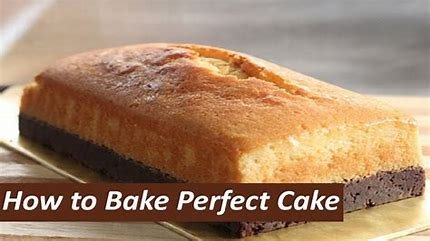Baking the perfect cake requires attention to detail, but with the right techniques and a bit of patience, anyone can do it!

1. Gather All Your Ingredients and Tools
- Basic Ingredients:
- All-purpose flour
- Sugar
- Eggs
- Butter (room temperature)
- Baking powder or baking soda
- Milk or other liquids (like buttermilk or cream)
- Vanilla extract (or other flavoring)
- Tools:
- Mixing bowls (preferably glass or stainless steel)
- Electric mixer or whisk
- Measuring cups and spoons
- Spatula
- Cake pan(s) (round, square, or rectangular)
- Parchment paper (optional)
- Cooling rack
2. Preheat the Oven
- Preheat your oven to the temperature specified in your recipe, usually between 325°F (163°C) and 350°F (177°C), depending on the type of cake. Make sure your oven is fully preheated before placing the cake inside to ensure even baking.
3. Prepare Your Cake Pan
- Grease your cake pan with butter or oil and dust with a little flour to prevent sticking. Alternatively, you can line the bottom with parchment paper for easy removal. This is especially useful for delicate cakes like sponge cakes.
4. Measure Ingredients Accurately
- Accurate Measurements Are Key: Use proper measuring cups and spoons for dry and wet ingredients. Too much flour can make your cake dry, and too little sugar can make it under-sweetened.
5. Cream the Butter and Sugar
- Butter and Sugar: Beat the butter and sugar together until light and fluffy. This process incorporates air into the batter, helping the cake rise and creating a lighter texture. It usually takes about 3-5 minutes with an electric mixer or 5-7 minutes by hand with a whisk.
6. Add the Eggs One at a Time
- Beat in the eggs one at a time, making sure each one is fully incorporated before adding the next. This prevents the mixture from curdling and ensures smooth batter.
7. Sift the Dry Ingredients
- Sifting Flour: Sift the flour, baking powder (or baking soda), and any other dry ingredients (like cocoa powder or spices) into a separate bowl to prevent clumps and ensure an even distribution of the leavening agents.
8. Alternate Adding Dry and Wet Ingredients
- Add Dry and Wet Ingredients Gradually: Start by adding about a third of the dry ingredients to the wet mixture, then follow with half of the liquid (milk or buttermilk), mixing gently after each addition. Repeat until all the dry and wet ingredients are incorporated. This ensures a smooth, lump-free batter and prevents over-mixing.
9. Mix Until Just Combined
- Avoid Overmixing: Mix the batter until the ingredients are just combined. Over-mixing can result in a dense, tough cake because it develops too much gluten.
10. Pour the Batter Into the Pan
- Pour the batter into the prepared cake pan and use a spatula to smooth the top.
11. Bake the Cake
- Place the cake pan in the preheated oven on the middle rack. Bake according to your recipe’s time recommendation (usually 25-35 minutes for a standard round cake). Check for doneness by inserting a toothpick or cake tester into the center of the cake. If it comes out clean or with just a few crumbs, the cake is done.
12. Cool the Cake
- Let the Cake Cool: Once your cake is baked, let it cool in the pan for about 10 minutes. Then, remove it from the pan and place it on a wire rack to cool completely. Cooling helps prevent the cake from becoming soggy.
13. Frost and Decorate
- Once the cake is completely cooled, it’s ready to be frosted. For a simple frosting, you can use buttercream, cream cheese frosting, or whipped cream. Make sure the frosting is spread evenly and you can even get creative with decorations (sprinkles, fruit, or edible flowers).
Tips for a Perfect Cake:
- Room Temperature Ingredients: Make sure your butter, eggs, and milk are at room temperature before starting. This allows them to mix better and results in a smoother batter.
- Don’t Overmix the Batter: Overmixing can make the cake dense and tough. Mix just until the ingredients are incorporated.
- Use the Right Pan Size: Using the correct size cake pan is crucial for even baking. If the pan is too small, the cake may overflow, and if it’s too large, the cake might bake too quickly and dry out.
- Don’t Open the Oven Door Too Soon: Opening the oven door too early can cause the cake to collapse. Wait until at least two-thirds of the recommended baking time has passed before checking.
- Cool Completely Before Frosting: Always let your cake cool completely before applying frosting. If the cake is warm, the frosting may melt or slide off.
With a little practice and attention to detail, you’ll be baking perfect cakes in no time. Enjoy the process, and don’t forget to share the delicious results!
